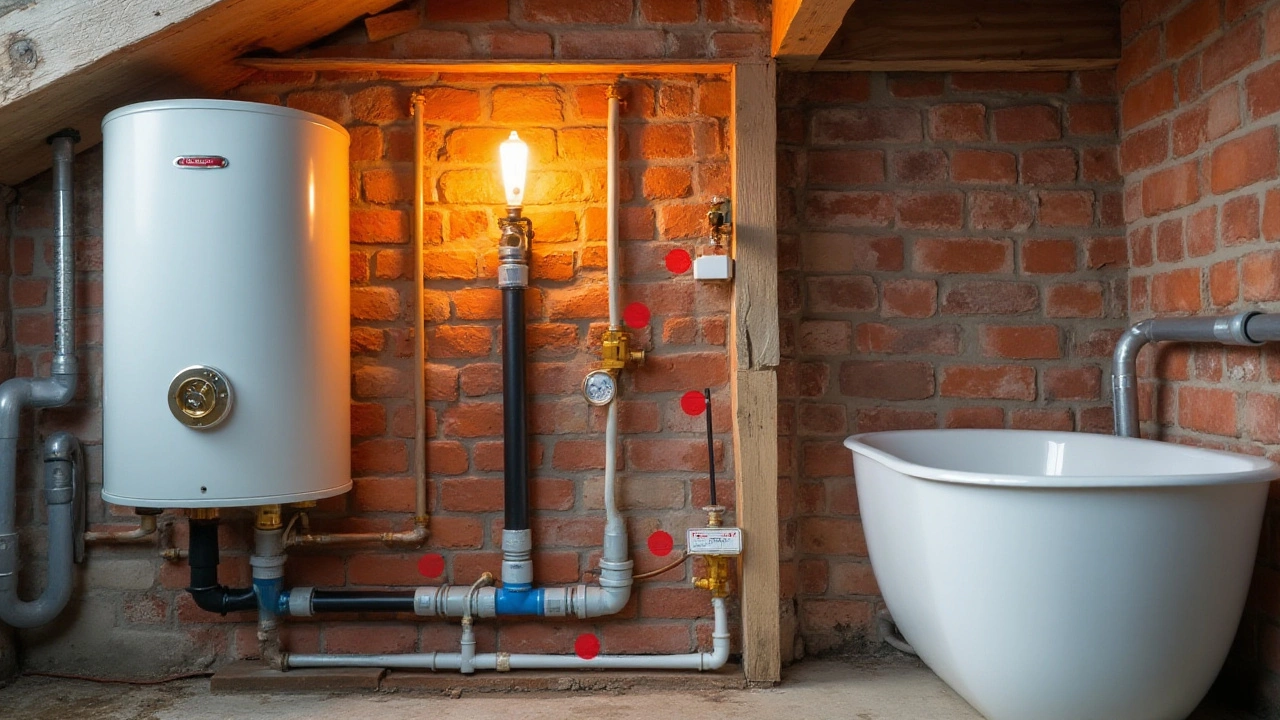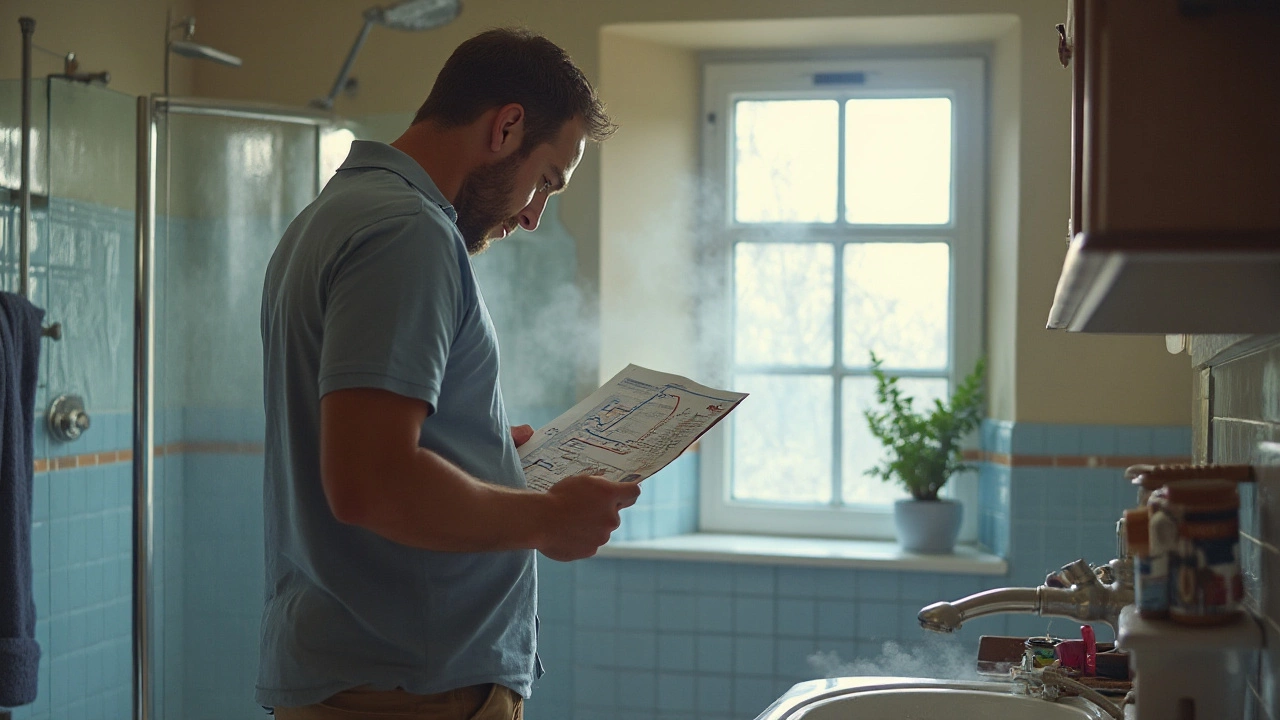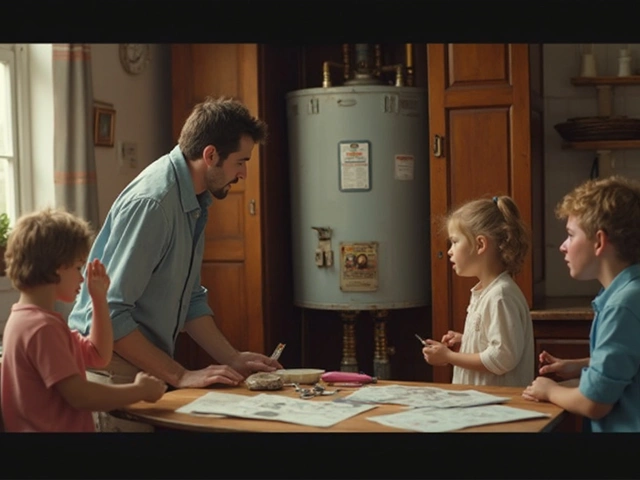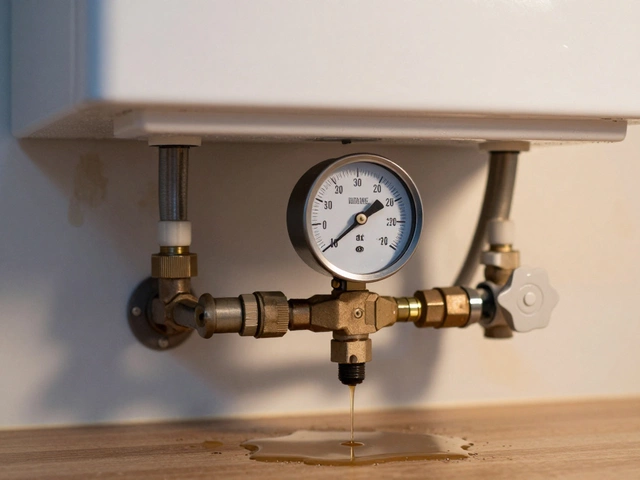Imagine stepping into your shower, ready for a warm wash, only to be met with an icy surprise. Meanwhile, your sink cheerfully supplies your usual hot water. It's a household mystery many might face, yet often left unexplored until the chill hits.
This cooling conundrum can stem from a variety of sources. Faulty parts or simple maintenance issues might be the culprits behind your relief of hot water quitting in the shower but not at the sink. With some knowledge and a few steps, this problem might not be as daunting as it first seems.
Let's delve into understanding why your plumbing might be playing these chilly tricks, arming you with the information you need to restore the warmth throughout your home.
- Common Causes of Cold Showers
- Role of Mixing Valves
- Water Heater Considerations
- Inspecting Pipes and Blockages
- Professional Help vs. DIY Solutions
- Preventative Measures for Future
Common Causes of Cold Showers
When your shower blasts cold water while the sink seems unaffected, it's easy to feel baffled and frustrated. One of the most common reasons lies within the intricate workings of plumbing systems themselves. A frequent culprit is the mixing valve, a crucial component designed to blend hot and cold water to the desired temperature. Over time, these valves can deteriorate or get stuck due to mineral deposits, particularly in areas with hard water. This malfunction can lead to a cold surprise, even though your sink's plumbing might not have experienced such wear and tear.
Diving deeper, even a relatively new home or system isn't immune from these hiccups. The water heater plays a vital role in maintaining hot water flow throughout your house. If it operates correctly for the sink yet fails when you switch on the shower, the reason might reside in the thermostat settings specific to parts of your plumbing network. Inconsistent thermostat levels can inadvertently favor some outlets over others. Swapping back and forth between different water outputs might provide clues, helping pinpoint the peculiar deviation in temperatures.
Another popular explanation is the buildup of sediment in the water heater tank over time. Particularly in regions where water carries a high mineral content, sediments can settle into the heater, causing it to underperform. With a 30% chance, let's consider the insightful words from a respected figure in plumbing.
“Sediment build-up is the silent enemy of home water heaters,” John Gallagher, a senior technician at Wellington's renowned HeatWise Services, observed, “and it often masquerades as a problem elsewhere, like at the shower.”Over time, sediments can decrease the heater’s efficiency, leaving you chilly after a long day.
Pipe sizes and lengths are similarly prone to causing confusion. If your shower is located farther away from the water heater than other fixtures, there might be additional stretches of pipe that cool the water before it even gets close to touching you. A peculiar fact to chew on: homes built before 1980 often have longer and narrower pipes as a traditional plumbing technique, contributing to this phenomenon more commonly than you'd guess in today's designs.
Finally, consider whether recent changes might've affected the balance — such as the installation of new appliances or water-saving adapters. At times, doing good for the environment tweaks the set-up, resulting in the unexpected. Guests might unknowingly increase overall water demand, sneaking the temperature to a cooler range that the shower fails to compensate for.
These are not exhaustive explanations but do paint a picture of what goes missing when a shower resists sharing the warmth. The good news is that most solutions don't demand heavy machinery or deep wallets, but a little detective work and patience. Armed with this knowledge, the warm embrace of your next shower might be just around the corner.
Role of Mixing Valves
At the heart of plumbing wizardry lies the often understated yet crucial mixing valve. These unassuming devices play a pivotal role in balancing the hot and cold water lines to deliver a consistent and desired water temperature, specifically in showers. Imagine them as the peacekeepers, managing the meeting point of hot and cold. If they fail, the result could be a cold surprise while showering, even as your sink runs hot.
Mixing valves are designed to maintain a stable temperature by dynamically adjusting the mix of hot and cold water based on pressure fluctuations in the system. It's a clever bit of engineering that ensures no sudden surprises during your morning routine. However, these valves can falter due to wear and tear, scale buildup, or even improper installation. When they do, the first sign is often a drastic temperature difference between various outlets in the house, like your shower and sink.
Interestingly, studies indicate that most mixing valve failures happen because of mineral deposits, especially in areas with hard water. This scale can accumulate over time and block the valve's inner workings, causing it to seize up or misbehave. Regular maintenance, like cleaning these deposits, can prolong the life of a mixing valve and help maintain a steady stream of warm water where needed. A neglected mixing valve is, more often than not, a ticking time bomb that can lead to those dreaded cold showers.
Understanding Valve Malfunctions
When diagnosing a puzzling cold shower scenario, consider the role of the mixing valve early on. Test the shower's temperature control by adjusting it to its limits. If there is no change, the valve might need attention or even replacement. Another indication of valve trouble is if the shower temperature is inconsistent, delivering a spectrum of temperatures throughout use. Interestingly, a reputable source, the International Association of Plumbing and Mechanical Officials (IAPMO), states, "The performance of a mixing valve significantly affects user satisfaction and system efficiency."
In many cases, a stubborn valve might just require a skilled touch rather than a full-on swap. Sometimes, dismantling and soaking it in a descaling solution can restore its functionality. But caution is key; embarking on such repairs without understanding the risks can lead to more serious issues, like leaks or damage that might require professional intervention. So if DIY doesn't seem right, calling in an expert becomes the next logical step.
Additionally, households with newer mixing valves benefit from advanced features that include anti-scald technology. This means the valve can automatically adjust in case of sudden changes in water pressure, such as when someone uses a sink nearby. While these are less likely to fail, they are also more complex, demanding a professional touch when problems arise. Understanding the specific model and its care instructions can save homeowners both time and money in the long run.

Water Heater Considerations
When faced with cold water in the shower but not at the sink, it's crucial to inspect the hot water heater itself. This device is the heart of your home's hot water system, and any hiccup here can ripple out to various faucets. Often, a malfunctioning heater stems from issues like a broken thermostat or sediment buildup within the tank, each of which can significantly affect the water temperature. The thermostat’s role is to gauge the water’s heat and signal the heater to either increase or decrease warmth. When it becomes faulty, even by mere degrees, you might find inconsistencies in different parts of your home.
Another key consideration is the age of your water heater. Most units are built to last 8 to 12 years, although consistent maintenance can extend their lifespan. As they age, components wear out and efficiency drops, which may lead to uneven water temperatures. Perhaps the water heater is placed at a considerable distance from the shower. Factors like these can cause cooling before water reaches the showerhead, especially during those early morning rituals when demand spikes.
Pay attention to the settings on your water heater as well. Sometimes, a simple adjustment can solve the problem. If your family has grown recently or you’ve changed your routine, you might need more hot water than before. Increasing the temperature slightly could compensate for the newfound demand. A word of caution here: no more than 49°C to avoid scalding risks. Consulting the user manual or the manufacturer's online resources can provide guidance specific to your model. Routine check-ups by a professional, though, often herald the best long-term performance from your unit.
"Proper maintenance of your water heater is vital not only for efficiency but for ensuring safe operation at all times," says John Smith, a certified plumbing expert from the renowned Water Heater Purveyors.
Understanding how sediment builds up in the tank over time can also shed light on the issue. As water enters the tank, minerals precipitate out, settling at the bottom. This sediment acts like a barrier, reducing the heater's ability to warm water effectively, and often results in frustrating cold water scenarios. This calls for regular flushing of the tank, ideally once every six months. Not only does this help maintain optimal performance, but it also extends the life of your unit.
In case your current water heater is beyond help, replacing it can seem daunting, yet it also presents an opportunity. There are numerous high-efficiency models available in the market now, ranging from tankless to solar-powered options. Tankless heaters, for instance, provide a continuous supply of hot water and can be more energy-efficient over time. These advancements not only promise hot showers every morning but also reduce energy bills, making them a perfect household investment. Choice and research in this area can offer solutions perfectly tailored to your needs, ensuring both comfort and efficiency in your home.
| Water Heater Lifespan | Expected Efficiency | Common Issues |
|---|---|---|
| 0-5 years | High | Minor thermostat issues |
| 5-10 years | Moderate | Increased sediment build-up |
| 10-15 years | Low | Major component failures |
Inspecting Pipes and Blockages
When your shower refuses to deliver hot water while the sink keeps up its end of the bargain, it might be time to consider what's happening with your pipes. Sometimes, the issue isn't with the water heater itself but how water travels through the labyrinth of pipes connecting everything in your home. Over time, debris, sediment, and even mineral deposits from the water can build up inside the pipes. This can create blockages, particularly in places where the pipe narrows or bends, limiting the flow. Imagine trying to hula hoop with someone squeezing the ring — not quite as fluid, right?
It’s important to look at how water flows through your plumbing system. Pipes that run from the water heater to your shower could be partially clogged. This could be due to mineral deposits, a common issue if you are using well water or if you live in an area with hard water. Over time, the minerals accumulate, narrowing the pipes just like cholesterol in arteries. If the water heater is functioning fine but delivering inconsistent hot water especially to the shower, this could be your smoking gun. As per a renowned plumbing specialist, "Regular maintenance of your plumbing can pre-empt larger, more damaging issues."
Another factor to consider is the age and condition of your pipes. Older pipes, particularly those made from metal, can corrode from within, contributing to blockages. With rust and particles flaking away, not only do you have buildup, but you also reduce the efficiency of water moving through your system. This can impact water pressure, which might explain your hot water woes. In some scenarios, you may notice a gradual decline in water temperature — an indicator that the blockage is getting worse.
Checking for visible points of stress along easily accessible pipes can also help diagnose issues. Cracks or leaks can allow air to enter the system, which might not block water but can lead to pressure drops. Tight turns and tricky joints are prime spots for clogs. While you’re it, gently tapping or listening for hollow sounds can sometimes give a clue as to where a blockage might be. Of course, don’t bang so hard as to damage your plumbing.
If you are comfortable enough and can trace the path, sometimes disconnecting a few sections can expose whether sediment buildup is the villain. Look for discolored water, grimy appearances, or foul odors – these might signal that your pipes are screaming for a good flush. While it’s not everyone's idea of a fun afternoon, a small effort here can save a potentially expensive call to a professional. However, remember the risks, and if you're unsure, it’s better to consult a professional than to wing it alone. Regular plumbing checks ensure that water and warmth flow freely.
It’s not a one-size-fits-all answer, and like many home maintenance issues, it often requires a bit of sleuthing to get to the root cause. Approach it methodically, and soon you might be back to basking in blissfully warm showers. Often, by understanding what goes through your pipes, you figure out how to ensure they continue serving you well — cold showers will be a relic of the past.

Professional Help vs. DIY Solutions
Faced with a cold shower while your sink flows with **hot water** might leave you pondering whether to break out the toolbox or phone a professional plumber. Each route has its merits and knowing when to DIY or call an expert is key. Attempting a plumbing problem fix yourself can add a valuable skill to your repertoire while saving a bit of cash. Yet, it's vital to differentiate between a simple fix and a perilous endeavor that could make matters worse.
For those with a bit of know-how, minor issues like cleaning clogged showerheads or checking simple valve adjustments might be straightforward. Start by examining your showerhead, as mineral buildup is a frequent cause of reduced water temperature. Look behind the shower faucet handle to locate and adjust the anti-scald valve, which could be set too low. These small yet significant checks can often restore the desired warmth without requiring professional intervention or extensive repair.
However, be cautious about diving into water heater alterations or accessing hidden pipes. Such tasks might necessitate expertise that's beyond the grasp of even the most enthusiastic DIYers. In the words of plumbing expert Joe Smith,
'A water heater is complex; tinkering without proper knowledge can lead to safety hazards or costly repairs.'If any step feels uncertain or security concerns arise, it's wise to reconsider your approach. Remember, it’s better to seek expertise than risk household safety.
Calling a professional is often the best choice for complex hot water issues. These pros bring an arsenal of knowledge and tools, ensuring your water heater repair is thorough and correct. They'll check thermostatic mixing valves, inspect for hidden leaks, and can even recalibrate your water heater system if necessary. Their expertise means you won’t have to worry about any surprises down the road. Bringing in professional help typically comes with a guarantee, allowing you peace of mind knowing the problem is resolved correctly.
Whether you decide on the DIY route or hire an expert, gathering some understanding about your water system is beneficial. An informed approach increases your confidence while ensuring your shower isn't something you dread each morning. Balancing skill level with the complexity of the *plumbing problem* can help keep your home’s plumbing healthy while maintaining your own sense of accomplishment and control.
Preventative Measures for Future
Keeping your home’s plumbing in top shape doesn't just prevent dismal cold shower experiences; it saves money, energy, and peace of mind. Regular maintenance can make all the difference when it comes to avoiding unexpected surprises, like a drain that suddenly stops gushing steaming hot water. By taking some sensible steps, you can ensure that your hot water is reliable and ready to go whenever you are. It starts with knowing a bit about the plumbing network and its components. A scheduled check-up of the water heater not only detects existing problems but also anticipates possible future hiccups. Keeping an eye out for leaks, which could silently be hampering hot water supply, needs to be a regular affair too. It’s worth understanding that a leak doesn't just waste water but money and precious energy too.
To help with these goals, consider installing insulating blankets around your water heater tank, if it's not already equipped with insulating properties. According to the U.S. Department of Energy, installing an insulating jacket can reduce standby heat losses and save between 7% and 16% on water heating costs. Branching out from just water heaters, pipe insulation comes as a handy assistant. Insulating hot water pipes reduces heat loss, allowing you to lower your water temperature setting and still get the hotness you crave. You’ll also have hot water faster, which can help save some water each time you open a tap. It’s a small change that doesn’t require much effort but delivers significant savings in the larger picture.
Another key measure involves the timely replacement of anode rods in the water heater. These rods often go neglected until their absence leaves you with a massive repair bill. Anode rods attend to the corrosive properties of water, thereby extending the life of your water heater. Checking these every couple of years pays off - both literally and figuratively. Engaging a qualified professional ensures that these replacements are timely and efficient, which is crucial for your system’s longevity.
Let’s touch upon addressing sediment build-up, which is a quiet adversary to all water systems. Flushing out the system at least once a year keeps sediment at bay, maintaining efficiency and hot water availability. While it might seem daunting, the process doesn’t require much, and guidebooks, as well as internet tutorials, make navigation easier than it sounds. Each of these measures echoes a simple truth - regular attention prevents bigger predicaments.
"Preventative maintenance is key to avoiding costly repairs and ensuring consistent access to hot water," advises Dr. Diane Smith, a renowned plumbing expert. Her insights highlight the importance of understanding your home's plumbing workings.
Lastly, technology lends a helping hand too. Smart thermostats, leak sensors, and other innovations act as modern caretakers. They allow for easy monitoring and control over hot water issues, offering solutions tailored to your usage patterns. Keeping abreast of these innovations can make a substantial difference in the hot water game. Ensuring that your water heating system always performs well is not an overwhelming process; it's a combination of attentive care, awareness, and a few key actions. And before you know it, your shower will never again surprise you with an unwanted burst of chilly water.






